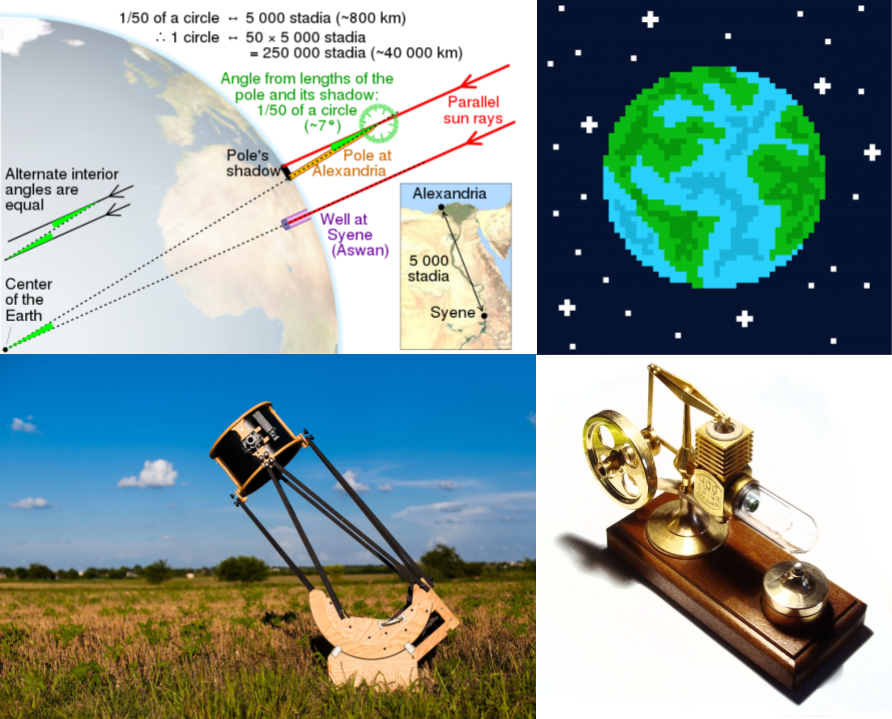Brainstorming

Before settling on a project, I went through quite a few other ideas — each with varying strengths and weaknesses.
Calculating the Radius of the Earth
Essentially what it sounds like — this would involve using measurements collected first hand to calculate the radius of the Earth. This process would likely look somewhat similar to the Greek mathematician Eratosthenes' method, with the angles of shadows being recorded at different locations, and that information used along with basic trigonometry to find the Earth’s radius.
Pros:
Orbital Mechanics Simulator
A basic orbital mechanics simulator that would likely be written in Python. It would include a few simulated planets and moons moving around on the screen, governed by calculated gravitational relationships. I could also introduce a small “spaceship” object and simulate the force of rocket engines on it at the right moments in time to imitate actual space missions — maybe try to recreate an Apollo style mission travelling from a low Earth orbit to a low lunar orbit and back.
Pros:
Telescope
A telescope that I’d design and construct (probably a Dobsonian) — it’d hopefully be powerful enough to make out some celestial objects. I would be able to fabricate some simple parts of it, like some parts of the body, which could be made out of wood, or some sort of pipe. I’d have to buy other parts, such as the mirrors/eyepiece.
Pros:
Stirling Engine
Stirling engines are powered by external heat flow. By placing such an engine between a heat source and a heat sink with a temperature imbalance, useful energy can be extracted as the system moves to equilibrium. Stirling engines contain a working fluid that transfers heat through the system. They also contain pistons which keep the fluid moving between the heat source and the heat sink so that the fluid can continue to transfer heat. As this happens, some of this energy is transferred to the pistons, and so energy can be extracted from them to perform useful work.
I’d design and construct a Stirling engine — likely with a footprint about the size of a notebook, or maybe smaller. I would fabricate some simple parts and purchase the rest. I’d use air as my working fluid, and the engine itself could be powered by a candle/ice cubes.
Pros:
Calculating the Radius of the Earth
Essentially what it sounds like — this would involve using measurements collected first hand to calculate the radius of the Earth. This process would likely look somewhat similar to the Greek mathematician Eratosthenes' method, with the angles of shadows being recorded at different locations, and that information used along with basic trigonometry to find the Earth’s radius.
Pros:
- Sounds fun, and I can be confident that I’ll never become a flat earther
- No additional resources required
- Very little physics involved
- The distances involved in a precise calculation are too large, so I might need to coordinate with someone else living far away
- The process and calculations are fairly straightforward, so there really isn’t very much to do
Orbital Mechanics Simulator
A basic orbital mechanics simulator that would likely be written in Python. It would include a few simulated planets and moons moving around on the screen, governed by calculated gravitational relationships. I could also introduce a small “spaceship” object and simulate the force of rocket engines on it at the right moments in time to imitate actual space missions — maybe try to recreate an Apollo style mission travelling from a low Earth orbit to a low lunar orbit and back.
Pros:
- Sounds pretty cool
- Tons of physics involved
- No additional resources required
- All of the work would be completely virtual (would mean even more time spent in front of a computer)
- I’m not fully sure how complicated some of the calculations involved would be, so this could end up being much more difficult than anticipated
Telescope
A telescope that I’d design and construct (probably a Dobsonian) — it’d hopefully be powerful enough to make out some celestial objects. I would be able to fabricate some simple parts of it, like some parts of the body, which could be made out of wood, or some sort of pipe. I’d have to buy other parts, such as the mirrors/eyepiece.
Pros:
- Sounds pretty cool, space is always interesting
- Need to source materials, these telescopes can get pretty big
- The physics are relatively simple for a simple telescope (I think), the real complexity lies in the geometry
- Not sure if I could actually construct a telescope with the precision required for it to be functional
Stirling Engine
Stirling engines are powered by external heat flow. By placing such an engine between a heat source and a heat sink with a temperature imbalance, useful energy can be extracted as the system moves to equilibrium. Stirling engines contain a working fluid that transfers heat through the system. They also contain pistons which keep the fluid moving between the heat source and the heat sink so that the fluid can continue to transfer heat. As this happens, some of this energy is transferred to the pistons, and so energy can be extracted from them to perform useful work.
I’d design and construct a Stirling engine — likely with a footprint about the size of a notebook, or maybe smaller. I would fabricate some simple parts and purchase the rest. I’d use air as my working fluid, and the engine itself could be powered by a candle/ice cubes.
Pros:
- Engines are neat
- Lots of physics involved
- Construction is plausible — even if it isn’t perfect, it should work (albeit with a lower efficiency)
- Need to source materials
- Small, delicate parts may be hard to fabricate (I do have a mini hobbyist CNC router, so it might be able to handle some of these parts)